Or perhaps the wisdom of the ages
If early to rise is part of the equation that makes a person “healthy, wealthy, and wise”, then our three breakfast times of 06:45, 06:00, and 06:30 the past three mornings would qualify everyone involved in this Road Scholar group. I can only speak to my earliness to bed and I’d say I failed to meet that requirement. However, since our flight to Cairns had an 08:45 scheduled departure, another early start was necessary if we were to get even the brief half-hour and from a distance look at Kata Tjuta that we had.
The same. But different physically
While it is also deemed a monolith, even seen from a distance
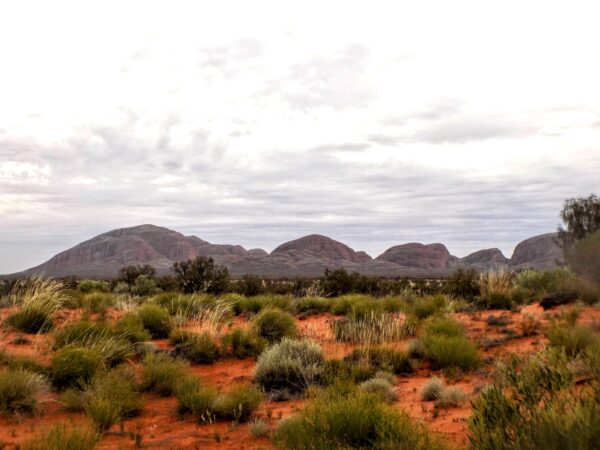
Kata Tjuta looks very different from Uluru. I’d guess the viewing area is at least two kilometers from Kata Tjuta but many of the rock’s 36 domes are distinguishable even from this viewing platform. While I’m certain Kata Tjuta would reveal much more from close up, one needs to get close to Uluru for it to appear as not quite so monolithic and for it to reveal all its ridges, caves, markings, and other features.
A previous post talked about the Petermann and Alice Springs Orogenies – the two mountain building events that brought both Uluru and Kata Tjuta to the surface so, in this section, we’ll leave the WABAC machine in the garage and look at some of the differences between the two sites.
Uluru, as we learned, is comprised mainly of arkose a highly compressed, coarse-grained sandstone that’s mainly feldspar. The fact that it formed from a rock fan (no roll fans involved as far as I can tell) that began as mainly sand allowed this extensive compression. Also called a monolith, the 36 giant rock domes of Kata Tjuta are conglomerate rock consisting of pebbles, cobbles, and boulders cemented together by mud and sand. It originated from a fan of water smoothed rocks.
The Alice Springs Orogeny tilted Uluru nearly 90 degrees leaving most of the rock below the surface. That same event tilted Kata Tjuta only between 15 and 20 degrees. This allowed the pair of rocks to erode differently. Where Uluru lacks any significant folding and faulting joints because of its composition, the major valleys of Kata Tjuta quite possibly resulted from the folding and faulting of the Alice Springs Orogeny.
All of these factors combined with different erosive processes to leave Uluru looking like this.
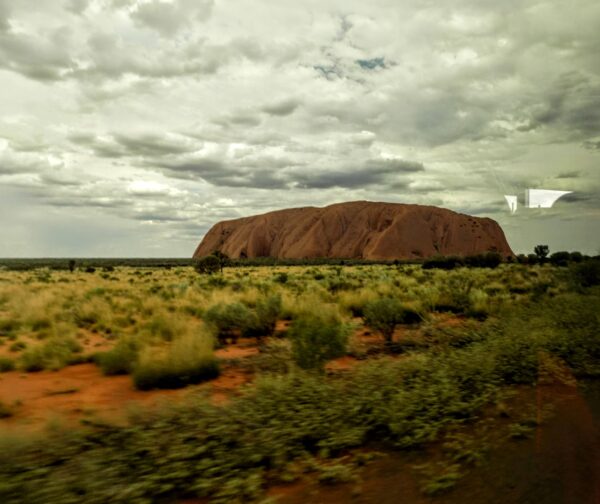
And Kata Tjuta looking like this.
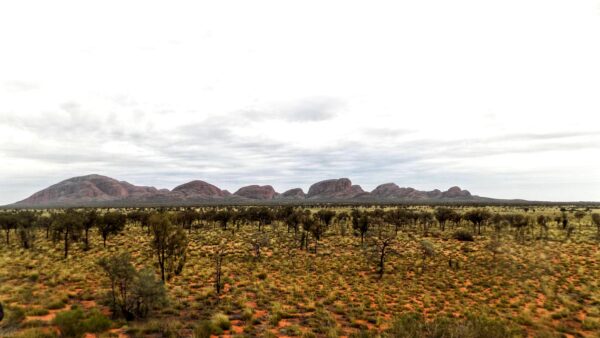
But also very different spiritually.
(Running deep beneath our world)
As we’ve learned, for the Aboriginal People even small stones and markers can have spiritual significance as part of their Dreaming so it makes sense that landforms as large as Uluru and Kata Tjuta would play an oversized role in the Tjukurpa or spiritual laws of the Anangu People who are the traditional caretakers of this Country. Kata Tjuta is so special that you can see this sign at Ayers Rock Airport (with apologies for my shaky hands):
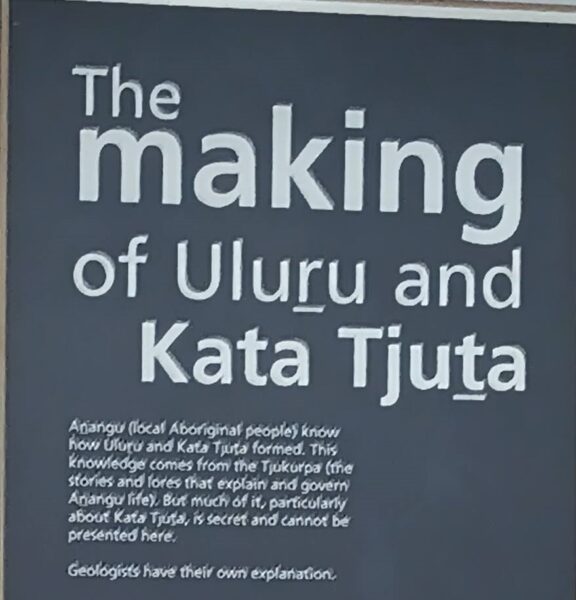
(If the sign is too difficult to read, it says, “Anangu (local Aboriginal people) know how Uluru and Kata Tjuta formed. This knowledge comes from the Tjukurpa (the stories and lores that govern Anangu life). But much of it, particularly about Kata Tjuta, is secret and cannot be presented here.”)
Further, the spirituality and Ceremony associated with Kata Tjuta connects specifically with men’s law according to Tjukurpa. At Uluru, while Tjukurpa dictates sex-specific responsibilities, Uluru has areas and stories that are significant to both men and women with women having their own designated spaces and roles for Ceremony. As at Kata Tjuta, these are integral to maintaining their cultural traditions and passing on knowledge to future generations.
As I noted previously, the Dreaming stories the Anangu and other Aboriginal people have shared are generally simplified versions that provide basic information and teach beginner’s lessons. The shared portions of the Dreaming stories associated with Kata Tjuta (at least the ones I have found) have even less detail.
The most prevalent Dreaming (on the internet) is that of Wanambi – a giant snake that formed rivers, gullies, and billabongs. For the Anangu People, Wanambi is said to dwell in a waterhole at the highest peak of Kata Tjuta during the rainy season and then to crawl down to the gorge in the dry season. Dark lines visible on the side of the rocks are his beard and his breath is manifest in the winds that blow through the gorge – gentle when he is calm but strong when he’s angry.
I found three additional Dreaming stories that had brief synopses attached. These are:
The Mice Women and Food: The mice women are domes on the eastern side of Kata Tjuta and two large rocks near the end of the peak are the food they are about to consume.
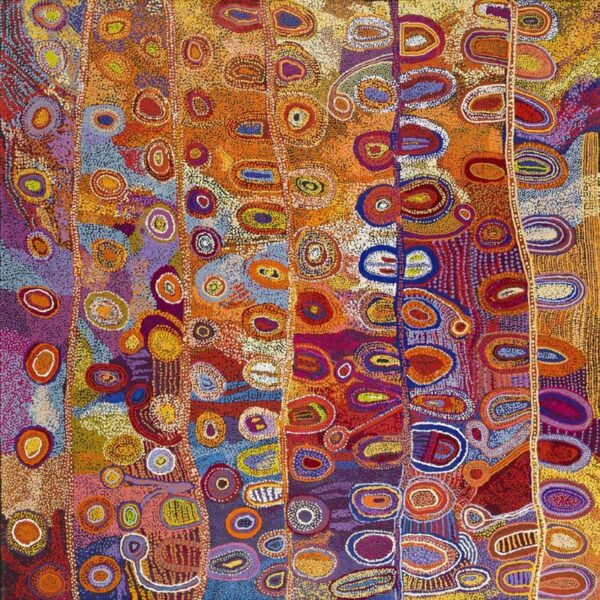
[Mrs Burton/Pitjantjatjara people/Australia SA 1925 – 2021/Angela Burton/Pitjantjatjara people/Australia SA b.1968 / Maureen Douglas / Pitjantjatjara people / Australia SA b.1966 / Mingkiri Tjukurpa (Mice Dreaming) 2011 Purchased 2012 with funds from Margaret Mittelheuser AM and Cathryn Mittelheuser AM through the Queensland Art Gallery Foundation / Accession No: 2012.269 / Collection: Queensland Art Gallery | Gallery of Modern Art / Copyright The Artists / Cited at https://collection.qagoma.qld.gov.au/objects/17683 on 10/02/2025]
Kangaroo-Man Malu: The Kangaroo-man Malu who is dying in his sister Mulumara’s arms can be found in a pillar on the rock’s eastern side.
Pungalunga Men: Certain domes on Kata Tjuta are Pungalunga men – giants who fed on Aboriginal People. The story tells of two hunters whose wives were eaten by a Pungalunga. Their plan to kill the giant had one man act as a decoy while the other speared it in the back. The Pungalunga died in Kuniula Cave, near Mulara Springs.
There may also be a connection to the story of Minyma Kuniya that’s more closely tied to Uluru. One source I found indicated that some of the domes on Kata Tjuta are also considered eggs of the Rainbow Serpent who guards the Mutitjulu Waterhole. (I had neither the time, inclination, or energy to research this any further.)
As I noted above, we had only a short 30 to 45 minutes at the Kata Tjuta viewing platform before we set off for the airport and our flight to Cairns. The flight is about two and a half hours long so I’ll use this time to provide you with a little more history about Uluru – Kata Tjuta National Park.
As you prepare for your history lesson, here are the other photos I managed from the day.